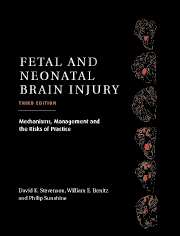Book contents
- Frontmatter
- Contents
- List of contributors
- Foreword
- Preface
- Part I Epidemiology, Pathophysiology, and Pathogenesis of Fetal and Neonatal Brain Injury
- Part II Pregnancy, Labor, and Delivery Complications Causing Brain Injury
- 9 Maternal diseases that affect fetal development
- 10 Antepartum evaluation of fetal well-being
- 11 Intrapartum evaluation of the fetus
- 12 Obstetrical conditions and practices that affect the fetus and newborn
- 13 Fetal and neonatal injury as a consequence of maternal substance abuse
- 14 Chorioamnionitis and its possible relation to subsequent cerebral palsy
- 15 Bacterial sepsis in the neonate
- 16 Neonatal bacterial meningitis
- 17 Neurological sequelae of congenital perinatal infection
- 18 Perinatal human immunodeficiency virus infection
- 19 Inborn errors of metabolism with features of hypoxic–ischemic encephalopathy
- Part III Diagnosis of the Infant with Asphyxia
- Part IV Specific Conditions Associated with Fetal and Neonatal Brain Injury
- Part V Management of the Depressed or Neurologically Dysfunctional Neonate
- Part VI Assessing the Outcome of the Asphyxiated Infant
- Index
- Plate section
13 - Fetal and neonatal injury as a consequence of maternal substance abuse
from Part II - Pregnancy, Labor, and Delivery Complications Causing Brain Injury
Published online by Cambridge University Press: 10 November 2010
- Frontmatter
- Contents
- List of contributors
- Foreword
- Preface
- Part I Epidemiology, Pathophysiology, and Pathogenesis of Fetal and Neonatal Brain Injury
- Part II Pregnancy, Labor, and Delivery Complications Causing Brain Injury
- 9 Maternal diseases that affect fetal development
- 10 Antepartum evaluation of fetal well-being
- 11 Intrapartum evaluation of the fetus
- 12 Obstetrical conditions and practices that affect the fetus and newborn
- 13 Fetal and neonatal injury as a consequence of maternal substance abuse
- 14 Chorioamnionitis and its possible relation to subsequent cerebral palsy
- 15 Bacterial sepsis in the neonate
- 16 Neonatal bacterial meningitis
- 17 Neurological sequelae of congenital perinatal infection
- 18 Perinatal human immunodeficiency virus infection
- 19 Inborn errors of metabolism with features of hypoxic–ischemic encephalopathy
- Part III Diagnosis of the Infant with Asphyxia
- Part IV Specific Conditions Associated with Fetal and Neonatal Brain Injury
- Part V Management of the Depressed or Neurologically Dysfunctional Neonate
- Part VI Assessing the Outcome of the Asphyxiated Infant
- Index
- Plate section
Summary
Introduction
Substance abuse is widely prevalent in our society and women in their child-bearing years are not immune to this epidemic. In addition to the many problems substance abuse causes for these women it also places the children they are carrying at risk for lifelong sequelae. Virtually all pregnant women are exposed to drugs in some form (such as acetaminophen, iron, multivitamins, and antimicrobials) and it is estimated that approximately 10% are exposed to illicit substances. The purpose of this chapter will be to describe the fetal and neonatal effects of various sensorium-altering licit and illicit substances ingested by pregnant women.
Drug distribution in pregnancy
Before discussing the various substances that may be ingested, it is important to understand general principles of drug distribution during pregnancy, including the roles of the placenta and breast in biotransformation and secretion. Drugs that are abused are capable of easily and rapidly entering the nervous system. The characteristics that favor transport of a drug across the lipoprotein barriers between the circulation and the central and peripheral nervous systems include high lipid solubility, minimal ionization at physiologic pH, low proteinbinding, and low molecular weight. High lipid solubility may result in storage of such substances in maternal body fat with subsequent release and transfer into fetal lipid stores during pregnancy. These same characteristics also enable drugs to cross the placenta readily and enter the fetal circulation.
- Type
- Chapter
- Information
- Fetal and Neonatal Brain InjuryMechanisms, Management and the Risks of Practice, pp. 274 - 302Publisher: Cambridge University PressPrint publication year: 2003

